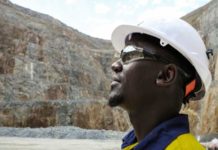
[miningmx.com] – IN the world of gold mining M&A heroics, does one plus one equal three? Nick Holland, CEO of Gold Fields, is hoping so.
The announcement earlier today that Gold Fields was to unbundle its South African assets – bar the South Deep mine on the west Rand – has received plaudits. Shares in Gold Fields ended Thursday (November 29) in Johannesburg up nearly 6% while, intriguingly, AngloGold Ashanti gained nearly 4%.
The question, however, is whether the new Gold Fields will be able to make South Deep work, a long-standing mining project with a track-record of serial under-performance? The new look Gold Fields is, to an extent, a gambit on the mine’s project ramp-up prospects.
It’s important to ask the question: with targeted annual production of 700,000 oz, South Deep represents a third of the 2.2 million ounces the new Gold Fields will produce; and comprise two-thirds of total resources.
“Yes,’ says Holland of South Deep’s ability to deliver. The mine has turned the corner technically, and in its readiness to ramp-up, he adds.
There’s also new agreement with labour to work 24 hours every day. And with about a tenth of the labour employed at the Gold Fields’ older mines, South Deep has the look of a mine international investors can stomach.
That’s because, at the end of the day, the unbundling of Gold Fields is for international investors, many of them ex-shareholders such as ASA (formerly American-South African Investment Company), founded in 1958 with a remit to buy South African mining shares. Another, perhaps surprising, absentee from Gold Fields’ share registry is Van Eck Global.
Van Eck’s senior metals and mining analyst, Charl Malan, believes Gold Fields is an exciting prospect. “It can work; I’m for this,’ he says.
Much depends on the ability of Neal Froneman, the CEO-designate of Sibanye Gold, to work some of his operational magic which is to cut costs, stabilise production and, in the longer term, recognise a good bolt-on deal.
“If Neal comes through, then in a year’s time, one plus one will be more than two,’ says Malan.
Infrastructure may not be the only bottleneck delaying the ramp-up of South Deep. Shoaib Vayej, a portfolio manager with Afena Capital, makes the interesting observation that South Deep has in the past failed to extract the productivity of even another asset in the Gold Fields group: the Australian mine Agnew. They use the same technology, but have differing results.
“There is some South African risk, but there’s project risk too,’ he says. Production targets of 700,000 oz for South Deep, it should also be remembered, comprises something of a soft downgrade from the previous 700,000 oz to 800,000 oz put on the mine, he says. “2013/14 will be the critical year. It’ll take a year or two to see.’
Gold Fields will also know that in sending Chucapaca, its Peru gold mining development, back to the drawing board that international growth can be as vexed as in South Africa. Projects don’t always align, the regulatory environment is becoming increasingly hazardous globally. Ridding itself – or “liberating’ as the Gold Fields’ spin would say – of South African assets doesn’t make growing a gold mine any easier.
As for Sibanye Gold, it has some early followers. “This is a new lease in life for Sibanye,’ says Piet Viljoen of Re:CM, the fund management company. “It’s a breath of fresh air,’ comments Pete Major, an analyst for Cadiz Corporate Solutions.
Says Sholto Dolamo, a fund manager for Stanlib: “I would buy it as it has this high dividend yield attraction, but it needs to contain costs and for the gold price to be in its favour’.











